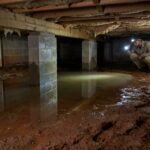Essential Strategies for Foundation Repair: Ensuring the Longevity of Your Home
When it comes to homeownership, concerns about foundation issues can feel like a storm cloud looming just over the horizon. Whether it’s minor cracks slowly creeping up your walls or the unsettling sensation of your house settling, foundation problems can trigger a mix of anxiety and disbelief—like finding out that your favorite ice cream parlor has closed down for good. But fear not! With the right strategies in place, you can tackle foundation repairs head-on and ensure your home stands strong for decades to come.
Understanding the Importance of Your Foundation
Before we delve into the nitty-gritty of foundation repair strategies, let’s take a moment to appreciate what the foundation really is: the unsung hero of your home. Think of it as the sturdy shoes your house wears; without a solid pair, everything else might just walk away—or worse, collapse under pressure. A strong foundation supports the entire structure, influencing the integrity and longevity of your home. It keeps your floors level, doors functional, and offers protection against weather elements.
However, like any diligent hero, your foundation may need some care and attention over time. Understanding how foundations function and the common issues they face will empower you to tackle potential problems before they escalate.
Common Foundation Problems
Foundations can develop issues due to various factors, including soil movement, water drainage problems, and even the time-honored tradition of settling. Some common signs that your foundation may need repairs include:
– **Cracks in Walls or Floors**: These can range from hairline fractures to gaping chasms (okay, maybe not that dramatic—yet). Pay attention to their width and length, as well as their location.
– **Uneven Floors**: If you find yourself playing a game of “Will My Coffee Spill?” because your floor feels like a rollercoaster ride, it might be time to investigate your foundation.
– **Doors and Windows Not Closing Properly**: Sticking doors and windows can signal that your house is shifting; after all, nobody likes feeling trapped, including your door.
– **Moisture Issues in the Basement**: Water pooling where it shouldn’t be can be a major red flag. After all, your basement isn’t supposed to double as an indoor swimming pool—unless that’s your style.
Essential Strategies for Foundation Repair
Now that we’ve identified the villains in our foundation drama, let’s discuss the essential strategies to ensure your home remains on solid ground.
1. Regular Inspection and Maintenance
Like any relationship, your home needs constant nurturing. Schedule regular inspections to check for signs of foundation problems. This can involve looking for cracks, inspecting drainage systems, and ensuring that gutters are clear. Remember, a little prevention goes a long way! Catching problems early can save you from dealing with costly repairs down the line. And let’s be honest—nobody enjoys unexpected expenses, especially when they come out of nowhere like an unsolicited pop quiz.
2. Proper Grading and Drainage
Water is often the arch-nemesis of foundations. If rainwater pools around your home, it can lead to considerable damage over time. Make sure your yard is properly graded so that water flows away from your foundation. You can achieve this by sloping the soil away from the house, installing French drains, or even considering the installation of a sump pump if your area has particularly high water tables.
3. Control Moisture Around the Foundation
Keeping moisture where it should be—not in your foundation—can significantly extend its lifespan. Ensure that gutters and downspouts direct water away from your home. Additionally, consider using landscaping features such as flower beds or retaining walls that encourage proper drainage.
4. Address Tree Roots
Trees can be beautiful, but their roots can wreak havoc on your foundation. When planting trees near your home, always consider their root growth potential. If you’re facing issues with tree roots damaging your foundation, consult with an arborist about the best course of action. Sometimes, strategic trimming can do wonders without sacrificing shade during those sweltering summer days.
5. Repairing Cracks
Small cracks in your foundation may look harmless, but they can lead to bigger problems if left unattended. Filling and sealing these cracks promptly can help prevent moisture infiltration. Many homeowners opt for epoxy or polyurethane seals, which expand and contract along with your foundation while keeping water at bay. If a crack keeps reappearing like an unwanted houseguest, consider consulting a professional about more extensive foundation repair.
6. Utilize Professional Foundation Repair Services
If you find yourself in over your head—perhaps staring hopelessly at a significant crack that resembles the Grand Canyon—don’t hesitate to call in the professionals. Foundation repair experts use specialized techniques such as underpinning, slab jacking, and piering to address severe issues. They have the tools, experience, and knowledge to diagnose problems accurately and provide effective solutions.
7. Monitor Soil Conditions
Soil conditions play a significant role in foundation stability. Expansive clay soils can swell and shrink dramatically with moisture changes, leading to foundation shifts. Regularly monitoring your soil’s condition, especially during wet and dry seasons, can prepare you for necessary adjustments. Consider using soil moisture sensors to gain insights into underground conditions.
8. Be Aware of Local Weather Conditions
In regions subject to excessive drought or heavy rainfall, understanding local weather trends can inform your foundation maintenance strategy. For example, during dry spells, you might need to use soaker hoses to maintain consistent moisture levels in the soil surrounding your foundation, preventing soil shrinkage. Conversely, knowing when heavy rains are expected can prompt you to double-check your drainage systems.
9. Insulate Pipes and Walls
Cold temperatures can cause pipes to freeze and burst, leading to water accumulation near your foundation. Insulating pipes and walls not only protects your plumbing but also helps keep excessive moisture from infiltrating your foundation.
10. Make Use of Landscaping
Believe it or not, Mother Nature can be your ally in foundation maintenance. Choose plants with non-invasive roots that require minimal watering and are drought-resistant. Native plants not only flourish in local soil conditions but also contribute positively to foundation stability.
The Bottom Line: Care for Your Foundation Like Your Car
Your home’s foundation is crucial for stability and safety, much like the engine of your car. Regular check-ups, timely repairs, and preventive measures are key to keeping it in great condition. Set reminders in your calendar for seasonal inspections and take the time to learn about your particular foundation type and its potential issues.
While passion for home improvement can drive you to tackle many tasks yourself, remember: there are times when it pays off to let professionals take the wheel. After all, would you trust your phone’s screen repair to a DIY tutorial found on the internet? (Pro tip: don’t.)
With dedication, regular maintenance, and a dash of wisdom, you can fortify your home against foundation issues. By implementing these essential strategies, not only will you ensure your house remains standing strong, but you’ll also avoid the sinking feeling that comes with neglected repairs. So go forth, empowered with knowledge, and maintain that foundation—your future self will thank you (and your home will too)!


